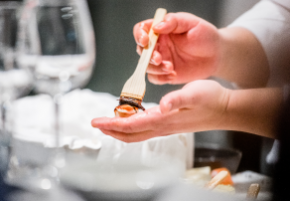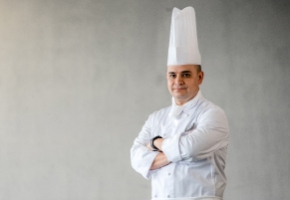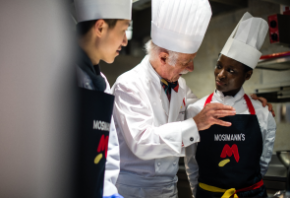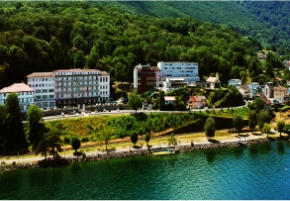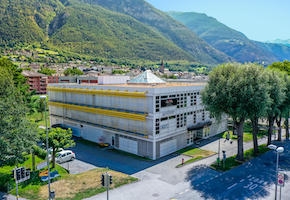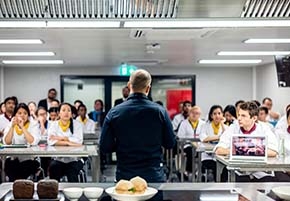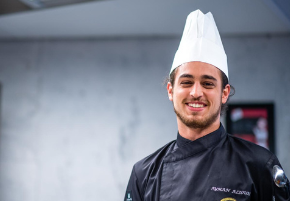- About
- Programs
- Campus Life
- Career Services
- Admissions
- News & Events
- Alumni
Who Invented Pancakes? A Look Back in Time
Discover who invented pancakes and how they evolved. Learn to make global favorites—start your culinary journey today
Key Takeaways
- Pancakes have been around for thousands of years, as suggested by the remains of ancient flatbreads found with Ötzi the Iceman and traces of prehistoric cooking found in places like Shanidar Cave.
- Many cultures have their own spin on pancakes, such as French crêpes, Indian dosas, Ethiopian injera, and Japanese okonomiyaki.
- Cookbooks played a significant role in standardizing pancake recipes and making them more accessible to home cooks worldwide.
Pancakes often bring to mind leisurely breakfasts, where something simple becomes something memorable. Whether fluffy and stacked or crisp and paper-thin, pancakes are a dish that feels both familiar and celebratory.
For many, pancakes are connected to personal traditions: Sunday mornings, the sound of batter hitting a hot pan, and the scent of syrup wafting through the kitchen. They feel timeless, as if they've always been a part of life. But where did they really come from—and who invented pancakes?
The Earliest Evidence of Pancakes
Some of the earliest evidence of pancake-like foods dates to prehistoric times, as archaeological discoveries suggest that rudimentary pancakes may have been one of humanity’s oldest cooked dishes.
A 2022 excavation at the Shanidar Cave complex in Iraq uncovered charred remnants of plant-based patties estimated to be around 70,000 years old. Researchers believe the ingredients were soaked, crushed, and shaped into flat cakes before being cooked—essentially creating one of the earliest forms of pancakes.
In Ancient Greece and Rome, pancake-style foods were already part of everyday cuisine. The Greeks called them "tagenites," made with wheat flour, olive oil, honey, and curdled milk. Romans prepared similar variations, aiding in the dissemination of the technique of cooking flat batter on hot surfaces throughout their empire. This simple yet adaptable method traveled across regions and eras, becoming a lasting part of global culinary tradition.
The Word “Pancake” and Its Origins
"Pancake" is a compound word. It combines the word "pan," referring to the tool used for cooking, and "cake," as a general term for baked or fried batter-based food. It’s a straightforward name that describes exactly what the item is—a sort of cake cooked in a pan
According to the Oxford English Dictionary, the earliest known use of this culinary term as a noun dates back to before 1400, during the Middle English period (1150 to 1500).
Pancakes Around the World
Although the base ingredients—flour, eggs, milk, and a leavening agent—remain relatively consistent, cultures around the world have transformed pancakes into distinctive regional specialties. A simple batter cooked on a hot surface becomes something entirely unique depending on local traditions, available ingredients, and culinary customs.
Crêpes (France)
Crêpes are among the most iconic dishes in French cuisine—thin, delicate, and remarkably versatile. Unlike pancakes, they contain no leavening agents beyond eggs, which gives them their signature paper-thin texture.
Sweet crêpes are often filled with Nutella, seasonal fruits, or whipped cream, while savory versions—made with buckwheat flour—are stuffed with ham, cheese, and eggs. They're typically folded into quarters or rolled into cylinders, allowing layers of flavor to shine through in every bite.
Blini (Russia and Eastern Europe)
Blini are small, yeasted pancakes traditionally made from wheat or buckwheat flour. Their texture is light but slightly spongy due to the rising dough, and they're typically served warm with sour cream, smoked salmon, caviar, or jam.
In Russian and Eastern European cultures, blini holds deep cultural and religious significance, particularly during Maslenitsa, a festival celebrating the end of winter. Their round, golden appearance also symbolizes the sun.
Dosa (India)
Dosa is a thin, crispy pancake made from a fermented batter of rice and urad dal (black lentils). Typically cooked on a hot griddle and spread into a wide circle, dosa develops a golden, lacy texture that adds to its appeal.
It’s a foundational dish in South Indian cuisine, often served with sambar, which is a lentil stew, and various chutneys. Masala dosa is a popular variation filled with a spiced potato mixture.
Okonomiyaki (Japan)
Okonomiyaki, which roughly translates to “grilled as you like it,” is a savory Japanese pancake made with ingredients like shredded cabbage, pork belly, seafood, and green onions, all mixed into a flour-based batter. It's cooked on a flat grill and topped with a signature combination of okonomiyaki sauce, mayonnaise, bonito flakes, and seaweed.
Regional variations offer even more character. In Hiroshima, for example, the ingredients are layered rather than mixed, often with noodles added for extra texture.
American pancakes (USA)
American-style pancakes are well known for their signature fluffy, thick, and often stacked-high style. They're made with flour, milk, eggs, sugar, and butter and typically served at breakfast with butter and maple syrup. Unlike French crepes, American pancakes gain their fluffy texture from adding baking powder, a common leavening agent in cakes.
Blueberries, bananas, chocolate chips, and other ingredients are often mixed into the batter. Their soft texture and slight sweetness make them a comfort food classic across the country.
Injera (Ethiopia)
Injera is a large, sour, spongy flatbread made from fermented teff flour. While technically a type of pancake, it plays a central role in Ethiopian and Eritrean cuisine, serving as both the base of the meal and a utensil. Its naturally tangy flavor comes from fermentation, and its porous texture is perfect for soaking up lentils, vegetables, and stews like doro wat.
Traditionally, injera is spread thin on a large griddle and cooked only on one side, creating its signature airy, bubbled surface.
Kaiserschmarrn (Austria)
Kaiserschmarrn is a fluffy, shredded pancake that’s lightly caramelized and typically served as a dessert or indulgent breakfast. Unlike American pancakes, Kaiserschmarrn gets its fluffy texture from a big dose of separated and whipped eggs.
The batter is made with eggs, flour, sugar, and milk, sometimes with raisins soaked in rum. Once cooked, the pancake is torn into bite-sized pieces in the pan, dusted with powdered sugar, and often served with fruit compote or applesauce.
Its name, meaning “Emperor's mess,” comes from the legend that it was a favorite dish of Emperor (Kaiser) Franz Joseph I.
Æbleskiver (Denmark)
These round, ball-shaped pancakes are a festive treat in Denmark, especially around Christmas. They're made from a batter similar to pancake or waffle mix and then cooked in a special pan with spherical molds.
Traditionally, they were filled with apple slices (hence the name), though now they're often served plain with powdered sugar and jam. Light and airy inside with a slightly crisp exterior, they are a delightful twist on the standard pancake.
Pancakes in Modern History
Today, finding a pancake recipe is as simple as searching online. In earlier centuries, however, people relied on handwritten notes, oral traditions, and family routines to recreate their favorite dishes.
By the 18th and 19th centuries, pancake recipes began appearing more frequently in printed cookbooks, providing home cooks and chefs with a consistent reference point.
Industrialization brought even more change. The development of shelf-stable ingredients like pre-mixed pancake flour, baking powder, and refined sugar reduced preparation time, making pancakes an easy, everyday option.
In the U.S., specifically, the rise of diner culture through the 20th century helped turn the pancake into a breakfast classic. Short stacks served with hot coffee, eggs, and sausage became as American as apple pie.
Fun Facts About Pancakes
Pancakes have made their mark in surprising ways across time and cultures. Here are a few fascinating facts that show just how far this humble dish has traveled:
- Ötzi the Iceman, a 5,300-year-old mummy discovered in the Alps, had remnants of a primitive pancake-like meal in his stomach.
- The largest pancake ever made was created in Rochdale, Manchester, UK, in 1994. It measured 15 meters in diameter, was an inch thick, and weighed nearly three tons.
- The highest pancake toss on record reached 9.47 meters and was achieved by Dominic Cuzzacrea in the United States in 2010, beating his previous record by 30 cm.
- The tallest stack of pancakes ever recorded reached an impressive 101.8 cm, created by Center Parcs Sherwood Forest in the UK on February 8, 2016.
- Pancake Day, also referred to as Shrove Tuesday, is celebrated 47 days before Easter Sunday.
- In 1889, one of the earliest mass-market pancake mixes was introduced in the U.S.—Aunt Jemima (later renamed Pearl Milling Company), which became a household name and a staple in American breakfast culture.
- In France, an old superstition says that if you flip a crêpe with one hand while holding a coin in the other, you'll be blessed with good luck and prosperity for the rest of the year.
- Even William Shakespeare gave pancakes a nod in his 1599 play "As You Like It," showing just how long they've been part of everyday life—and even literary history.
Bring Authentic Flavors to Your Modern Table
Some of the world's best chefs aren't praised as much for their avant-garde dishes or rare ingredients as they're celebrated for how they elevate the simplest of foods. The skill needed to take something classic, like the pancake, and make it feel refined or even new comes from dedicated practice, an understanding of technique, and a creative vision that is sharpened by proper culinary training.
At Culinary Arts Academy Switzerland (CAAS), students are given the tools to do that. The school offers two strong options: a Diploma in Pastry Arts for those who want to specialize in all things sweet or a BA Degree in Culinary Arts for students aiming to master both the kitchen and the business side of food. Either way, it's about building a strong foundation and pushing your craft further—so you can recreate recipes but also reinvent them.
And remember—every chef knows that the first pancake usually isn't perfect. It sticks, it burns, and it tears a little. But you don't throw in the towel; you adjust the heat, change the pan, trust your instincts—and try again. It's the same with cooking, learning, and building a future in the culinary world. The next pancake is always better. So, take that step toward improvement and pursue a culinary degree with us at CAAS.
Frequently Asked Questions
Are pancakes healthy or unhealthy?
It generally depends on how they're made—traditional pancakes can be quite high in sugar and refined flour, but healthier versions using whole grains, fruits, or less sugar offer a more balanced option.
What’s the difference between pancakes and flapjacks?
In the U.S., the terms pancake and flapjack are often used interchangeably, but in the UK, a flapjack is a baked oat bar made with butter, sugar, and syrup
Interested in studying at CAAS? Download our brochure to learn about our programs!


